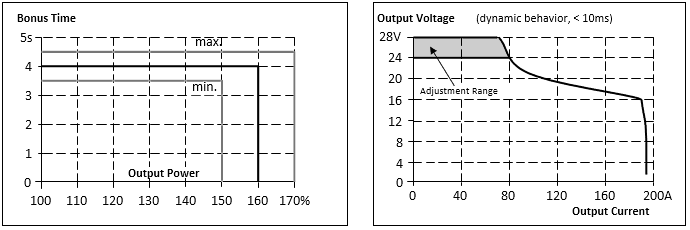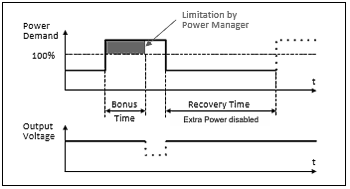Output
Output voltage | nom. | 24V |
|
Adjustment range |
| 24-28V | guaranteed |
max. | 30V***) | at the clockwise end position of the potentiometer | |
Factory setting | typ. | 24.1V | ±0.2%, at full load, cold unit, in “single use” mode |
typ. | 24.1V | ±0.2%, at full load, cold unit, in “parallel use” mode | |
typ. | 25.1V | at no load, cold unit, in “parallel use” mode | |
Line regulation | max. | 10mV | 475-750Vdc |
Load regulation | max. | 50mV | In “single use” mode: static value, 0A → 40A, |
typ. | 1000mV | In “parallel use” mode: static value, 0A → 40A, | |
Ripple and noise voltage | max. | 100mVpp | 20Hz to 20MHz, 50Ohm |
Output current | nom. | 40A | continuously available at 24V, |
nom. | 34.3A | continuously available at 28V, | |
nom. | 60A | short term (4s) available Extra Power*), at 24V, | |
nom. | 51.5A | short term (4s) available BonusPower*), at 28V, | |
nom. | 28A | continuously available at 24V, 320-474Vdc | |
nom. | 24A | continuously available at 28V, 320-474Vdc | |
typ. | 100A | up to 10ms, output voltage stays above 20V, See chapter “Peak current capability” for more peak current measurements. | |
Output power | nom. | 960W | continuously available at 24-28V |
nom. | 1440W*) | short term available Extra Power*) at 24-28V | |
Extra Power time | typ. | 4s | duration until the output voltage dips, see Fig. “Bonus time vs. output power” |
Recovery time | typ. | 7s | overload free time to reset power manager, see Fig. “Extra Power recovery time” |
Overload behaviour |
| continuous current | see Fig. “Output voltage vs. output current in “single use” mode, typ.” |
Short-circuit current**) | min. | 40A | continuous, load impedance 25mOhm, |
max. | 44A | continuous, load impedance 25mOhm, | |
min. | 60A | short-term (4s), load impedance 25mOhm, | |
max. | 68A | short-term (4s), load impedance 25mOhm, | |
typ. | 46A | continuous, load impedance <10mOhm | |
max. | 51A | continuous, load impedance <10mOhm | |
typ. | 190A | up to 10ms, load impedance <10mOhm, | |
Output capacitance | typ. | 10.200µF | included in the power supply |
*) Extra Power, short term power capability (up to typ. 4s) The power supply is designed to support loads with a higher short-term power requirement without damage or shutdown. The short-term duration is hardware controlled by an output power manager. This Extra Power is repeatedly available. Detailed information can be found in chapter “Repetitive pulse loading”. If the power supply is loaded longer with the Extra Power than shown in the bonus-time diagram (see Fig. “Bonus time vs. output power”), the max. output power is automatically reduced to 960W. |
**) Discharge current of output capacitors is not included. |
***) This is the maximum output voltage which can occur at the clockwise end position of the potentiometer due to tolerances. It is not guaranteed value which can be achieved. The typical value is about 28.5V. |

Output voltage vs. output current in “parallel use” mode, typ.

Dynamic overcurrent capability, typ.

The Extra Power is available as soon as power comes on and after the end of an output short circuit or output overload.
